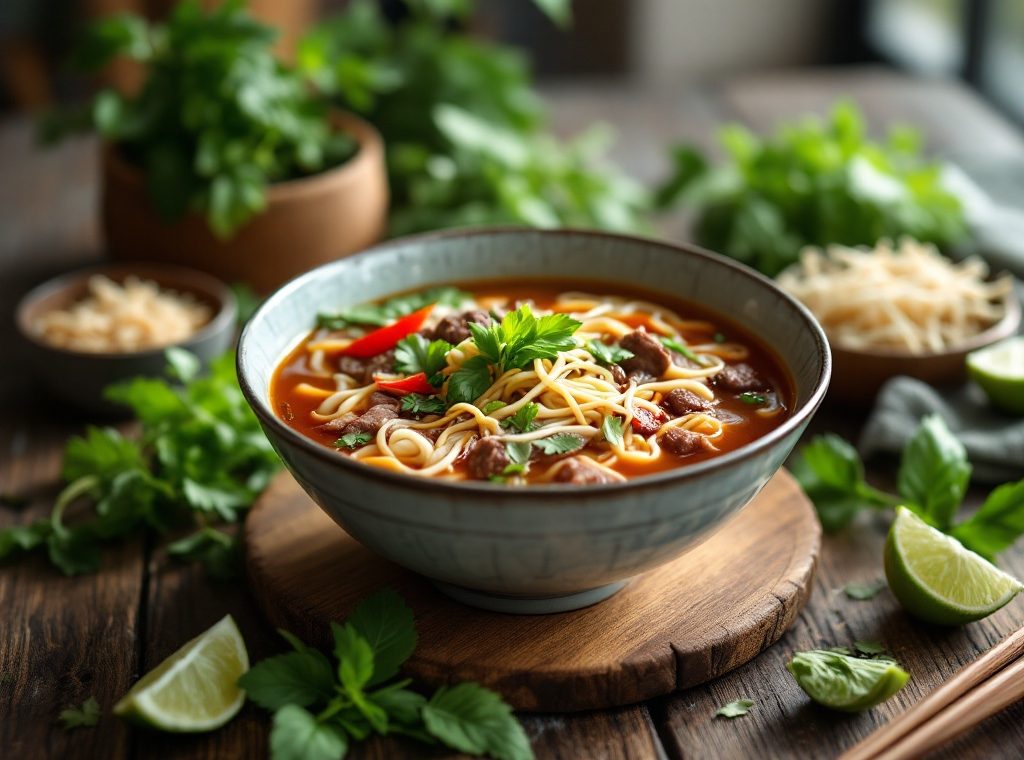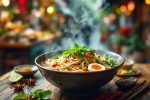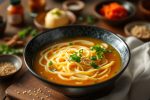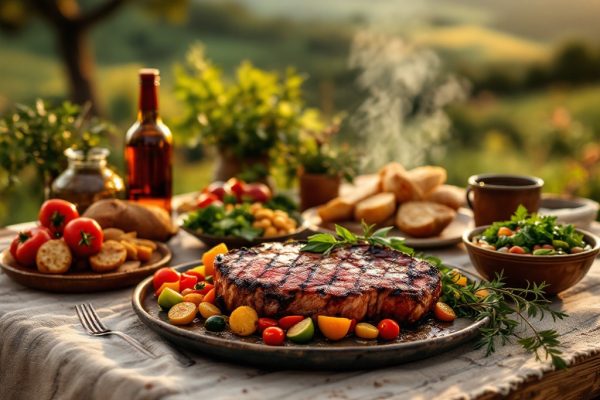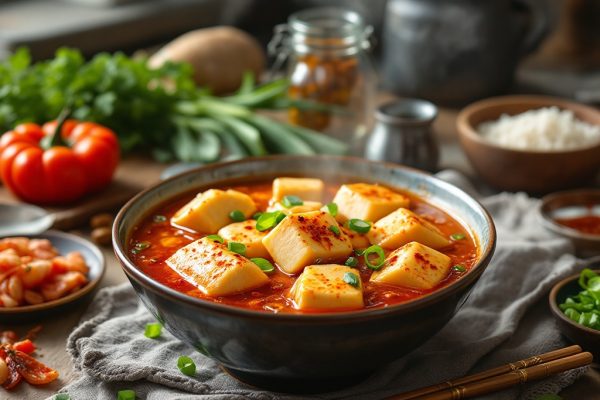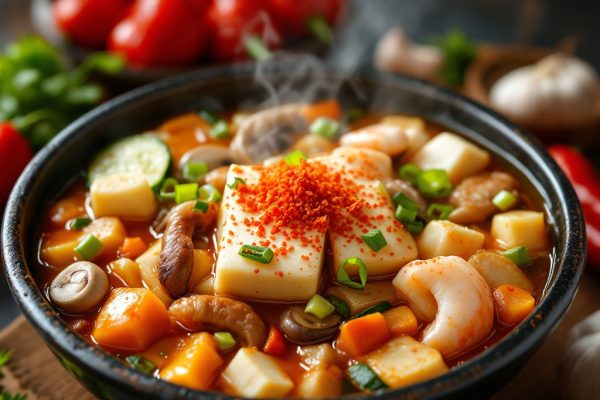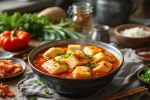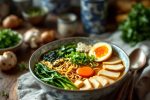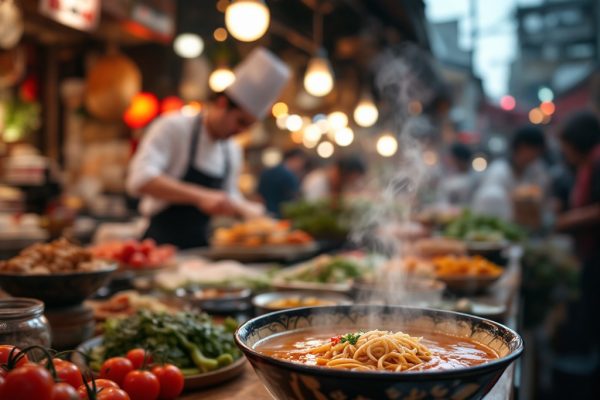How to Make the Famous Pho Soup from Vietnam
Craving a flavorful and comforting meal? Discover the secrets of Pho, Vietnam’s iconic noodle soup. This aromatic dish features a rich broth simmered with beef bones and spices, tender rice noodles, and thinly sliced beef. Learn how to create the perfect bowl with fresh herbs, bean sprouts, and zesty lime. Explore variations like chicken or vegetarian Pho and master the art of making Pho broth from scratch. Dive into our step-by-step guide and elevate your culinary skills today!
Important information

- Pho is a Vietnamese noodle soup with a rich broth, rice noodles, and thinly sliced meat (typically beef), along with fresh herbs and toppings.
- The broth is key, simmered with beef bones, spices like star anise, cloves, and cinnamon for hours to extract deep flavor.
- Fresh basil, cilantro, bean sprouts, lime, and chili are common toppings, allowing for customization.
- The meat is often added raw to the bowl and cooked by the hot broth. Common beef choices include eye round, sirloin, and brisket.
- Variations exist, like chicken (Phở Gà) and vegetarian/vegan versions.
Understanding Pho: A Traditional Vietnamese Noodle Soup
Pho, a cherished Vietnamese dish, is a flavorful noodle soup perfect for any meal. This comforting soup features rice noodles in a rich broth simmered with beef bones, star anise, cloves, and cinnamon. Thinly sliced beef (brisket, flank steak, or shank) adds protein. Fresh toppings like bean sprouts, basil, cilantro, and chilies provide a vibrant contrast. The savory, spice-infused broth complements the tender meat and herbs, creating a balanced and satisfying meal.
Key Ingredients for Making Pho Soup
Pho’s deliciousness comes from a few key components. The foundation is a bed of rice noodles. A flavorful broth, simmered from beef bones and spices like star anise, cloves, and cinnamon, adds depth. Fresh herbs, such as basil, cilantro, and onion, brighten the dish, while bean sprouts offer a pleasant crunch. For a personalized touch, add lime, chili, and hoisin sauce. Thinly sliced beef is the traditional meat, but chicken or tofu are excellent alternatives.
Broth: The Heart of Pho
Pho’s rich, flavorful broth starts with collagen-rich beef bones and marrow. What sets pho apart is the careful blend of spices and aromatics simmered slowly to extract their deep essence. This fragrant broth is ladled hot over noodles and thinly sliced meat, creating a satisfying meal.
Rice Noodles: The Base of the Soup
Rice noodles, called bánh phở, are the heart of a good pho. These flat noodles are essential, but proper cooking is crucial. Follow the package directions to avoid overcooking, as they’ll soften further in the hot broth. Perfectly cooked noodles are key to a perfect bowl of pho.
Fresh Herbs and Vegetables
Fresh herbs and vegetables are essential for a truly delicious bowl of pho. Popular choices include basil, cilantro, culantro, and Thai basil. Alongside these aromatic herbs, you often find bean sprouts, lime wedges, and chilies. A quick five-second blanch softens the bean sprouts perfectly. Diners then personalize their pho by adding these fresh ingredients to their liking.
Essential Spices and Aromatics
The flavorful base of pho is built upon warm, aromatic spices. These include star anise, cloves, black cardamom, and cinnamon, creating an inviting warmth. This warmth is complemented by the bright citrus notes of coriander seeds and a subtle hint of licorice from fennel. Toasting these spices unlocks a deeper, more complex flavor in the broth.
Beef and Raw Meat Options
Pho enthusiasts often enhance their steaming bowls with thinly sliced raw beef, allowing the hot broth to gently cook the meat. Popular cuts include eye round, sirloin, and brisket, each contributing distinct flavors and textures to the pho.
Step-by-Step Guide to Making Pho Broth
Select the right bones. Beef bones are the traditional choice, while oxtail and marrow bones add a rich depth of flavor.
Toast the spices. Intensify the aroma of star anise, cloves, and cinnamon by toasting them before simmering.
Simmer slowly and steadily. Extract maximum flavor from the bones and spices by simmering them for several hours.
Create a savory base. Combine the slow-simmered broth with fish sauce for a savory foundation.
Enhance the flavor profile. Add aromatics like onions and ginger to further enhance the flavor.
Maintain a clear broth. Regularly skim the broth to remove impurities, ensuring a pristine final presentation.
Choosing the Right Bones: Beef, Oxtail, and Marrow Bones
Beef bones, especially oxtail and marrow bones, form the foundation of pho. These contribute collagen to the broth, resulting in its rich, flavorful character.
Toasting Spices for Enhanced Flavor
Toasting spices dramatically enhances the flavor of your pho by releasing their aromatic oils, creating a richer and deeper taste and aroma. Common spices like star anise, cloves, cinnamon, coriander seeds, and black peppercorns are transformed by this simple process. Simply toast them in a dry pan over medium heat until fragrant, then add them to your simmering broth for a truly elevated pho experience.
Simmering Techniques for a Rich Broth
Gently simmer the broth for 6–8 hours, or even overnight, to extract rich flavors from the bones and spices. A low heat is essential. Avoid a rolling boil to ensure a clear broth. Regularly skim off any foam or impurities that rise to the surface, further enhancing the broth’s clarity and overall quality.
Flavoring with Fish Sauce and Aromatics
Fish sauce is essential for authentic pho, lending a savory, umami depth to the broth. Aromatic ingredients like onions, ginger, and star anise further enhance the flavor profile with their complex notes. The key lies in balancing the salty fish sauce with these aromatics. Too much fish sauce can overwhelm the delicate spices, while too little leaves the broth bland. This careful balance defines a truly delicious bowl of pho.
Maintaining a Clear Broth
Regularly skim the surface of your broth to remove impurities and keep your pho clear and appealing.
Cooking Techniques for Perfect Pho Noodles
Cooking rice noodles for pho is easy. Follow these steps:
Check the package directions for specific cooking instructions.
For dried noodles, soak them in hot water to soften before adding to the broth.
Alternatively, boil the noodles briefly until tender yet firm.
Rinse the noodles under cold water to prevent overcooking and sticking.
To keep bean sprouts crisp, blanch them quickly.
Boiling Rice Noodles: Following Package Instructions
Prepare your rice noodles according to the package directions to achieve the perfect texture for your pho. Some brands recommend a quick soak in warm water.
Blanching Bean Sprouts for Crispness
A quick, five-second blanch in boiling water slightly softens bean sprouts while preserving their delightful crunch.
Assembling the Perfect Bowl of Pho
Place cooked rice noodles in a bowl and top with thinly sliced raw beef.
Pour hot broth over the noodles and beef, cooking the beef in the process.
Garnish with fresh toppings such as basil, cilantro, bean sprouts, and lime wedges.
Adding Thinly Sliced Raw Beef
Thinly sliced raw beef, typically eye of round or sirloin, is placed in a bowl. Hot broth is then poured over the meat, gently cooking it to a tender, delicate texture. This process also infuses the pho with a rich, savory flavor.
Ensuring the Broth is Super Hot
A key step is boiling the broth, which thoroughly cooks the raw beef while gently warming the other ingredients. This quick heating process ensures everything is cooked through but prevents the beef from becoming overdone, preserving the flavors of all the components.
Incorporating Toppings and Garnishes
Fresh herbs like basil, cilantro, and culantro brighten the dish with a wonderful fragrance. Bean sprouts add a satisfying crunch, while a squeeze of lime delivers a burst of citrus. Sliced onions and chili peppers provide a sharp kick.
Serving with Condiments: Hoisin Sauce, Sriracha, and Lime
Pho is often served with hoisin, sriracha, and lime, allowing you to personalize your bowl. A squeeze of lime brightens the broth. Sriracha delivers a fiery kick. Hoisin sauce adds a touch of sweetness and savory umami depth. Enjoy customizing your pho to your liking!
Exploring Variations: Phở Gà, Phở Bò, and Vegetarian/Vegan Pho
Phở Gà, a flavorful yet simple chicken-based soup, contrasts with Phở Bò, which features various beef cuts like rare steak, brisket, or meatballs. Vegetarian and vegan options substitute tofu, mushrooms, or vegetables, complemented by a rich vegetable broth. While these variations cater to diverse preferences, they all retain the essence of Phở. Regional distinctions, particularly between North and South Vietnam, influence the sweetness of the broth and the choice of toppings and meats.
Northern Phở
Typically less sweet broth.
Southern Phở
Often boasts a sweeter taste.
Tips for Making Pho Ahead and Freezing Instructions
Prepare your pho broth and noodles ahead of time.
Chill the broth completely and store it in airtight containers in the refrigerator for up to four days. For longer storage, freeze the broth flat in freezer bags for up to three months.
Store cooked noodles separately in airtight containers in the refrigerator for up to two days.
Thaw the frozen broth overnight in the refrigerator and gently reheat it on the stovetop or microwave, avoiding boiling.
Quickly reheat the noodles in boiling water.
Just before serving, assemble your pho and add fresh garnishes.

